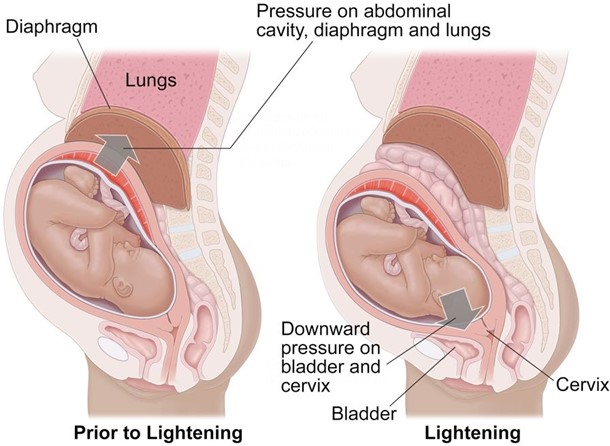An infant of a Diabetic Mother (IDM) has a blood glucose of 60 upon admission to the well-baby nursery. Which of the following is an appropriate nursing action?
Select one:
Prepare for IV dextrose administration.
Provide routine care, per hospital IDM protocol.
Place the infant in a warmed incubator.
Alert the clinician immediately for orders.
The Correct Answer is B
Choice A Reason: Prepare for IV dextrose administration. This is an incorrect answer that indicates an unnecessary and invasive intervention for an IDM with normal blood glucose. IV dextrose administration is indicated for an IDM with severe or persistent hypoglycemia, which is defined as a blood glucose below 40 mg/dL or below 60 mg/dL after two feedings.
Choice B Reason: Provide routine care, per hospital IDM protocol. This is because a blood glucose of 60 is within the normal range for an IDM, which is 40 to 80 mg/dL. An IDM is a newborn whose mother has pre-existing or gestational diabetes, which can affect the fetal and neonatal glucose metabolism and regulation. An IDM may have hypoglycemia (low blood glucose), hyperglycemia (high blood glucose), or other complications such as macrosomia, polycythemia, or congenital anomalies. An IDM requires routine care and monitoring according to the hospital IDM protocol, which may include blood glucose testing, feeding, temperature regulation, and observation for signs of distress.
Choice C Reason: Place the infant in a warmed incubator. This is an incorrect answer that suggests an irrelevant and potentially harmful action for an IDM with normal blood glucose. Placing the infant in a warmed incubator is indicated for an IDM with hypothermia, which is a low body temperature that can impair glucose utilization and increase oxygen consumption. However, placing the infant in a warmed incubator without proper indication can cause hyperthermia, which is a high body temperature that can lead to dehydration, electrolyte imbalance, or brain damage.
Choice D Reason: Alert the clinician immediately for orders. This is an incorrect answer that implies an urgent and unwarranted situation for an IDM with normal blood glucose. Alerting the clinician immediately for orders is indicated for an IDM with signs of distress or complications, such as apnea, cyanosis, seizures, or jaundice.
Nursing Test Bank
Naxlex Comprehensive Predictor Exams
Related Questions
Correct Answer is D
Explanation
Choice A Reason: Retained placental fragments. This is an incorrect answer that refers to a different cause of late postpartum hemorrhage, which is less common than uterine atony. Retained placental fragments are pieces of placenta that remain atached to the uterine wall after delivery, which prevent uterine contraction and involution, and provide a source of bleeding and infection. Retained placental fragments can be caused by abnormal placentation (such as placenta accreta), manual removal of placenta, or incomplete separation of placenta.
Choice B Reason: Cervical or vaginal lacerations. This is an incorrect answer that refers to a different cause of late postpartum hemorrhage, which is more likely to cause early postpartum hemorrhage than late postpartum hemorrhage. Cervical or vaginal lacerations are tears or cuts in the cervix or vagina that occur during delivery, which can cause bleeding from the damaged blood vessels. Cervical or vaginal lacerations can be caused by rapid or instrumental delivery, large or malpositioned fetus, or episiotomy.
Choice C Reason: Uterine inversion. This is an incorrect answer that refers to a different cause of late postpartum hemorrhage, which is rare and life-threatening. Uterine inversion is a condition where the uterus turns inside out and protrudes through the cervix and vagina after delivery, which can cause massive bleeding and shock. Uterine inversion can be caused by excessive traction on the umbilical cord, fundal pressure, or uterine relaxation.
Choice D Reason: Uterine atony. This is because uterine atony is a condition where the uterus fails to contract and retract after delivery, which leads to bleeding from the placental site. Uterine atony is the most common cause of late postpartum hemorrhage, accounting for about 75% of cases. Late postpartum hemorrhage is excessive bleeding from the uterus or genital tract that occurs more than 24 hours but less than 12 weeks after delivery. Late postpartum hemorrhage can be caused by retained placental fragments, subinvolution of the uterus, infection, or coagulation disorders.
Correct Answer is D
Explanation
Choice A Reason: Frequent voiding encourages sphincter control. This is an incorrect statement that has no relevance to labor and delivery. Sphincter control refers to the ability to contract and relax the muscles that control urination and defecation. It is not affected by frequent voiding.
Choice B Reason: A full bladder impedes oxygen flow to the fetus. This is an incorrect statement that confuses a full bladder with a prolapsed cord. A prolapsed cord is a condition where the umbilical cord slips through the cervix before the baby and becomes compressed by the fetal head, which can reduce oxygen flow to the fetus. A full bladder does not affect oxygen flow to the fetus.
Choice C Reason: Frequent voiding prevents bruising of the bladder. This is an incorrect statement that exaggerates the effect of a full bladder on the bladder wall. A full bladder may cause some pressure or discomfort on the bladder, but it does not cause bruising or damage.
Choice D Reason: A full bladder can impede fetal descent. This is a correct statement that explains why it is important for the nurse to assess the bladder regularly and encourage the laboring client to void every 2 hours.

Whether you are a student looking to ace your exams or a practicing nurse seeking to enhance your expertise , our nursing education contents will empower you with the confidence and competence to make a difference in the lives of patients and become a respected leader in the healthcare field.
Visit Naxlex, invest in your future and unlock endless possibilities with our unparalleled nursing education contents today
Report Wrong Answer on the Current Question
Do you disagree with the answer? If yes, what is your expected answer? Explain.
Kindly be descriptive with the issue you are facing.
